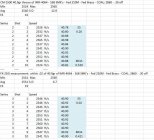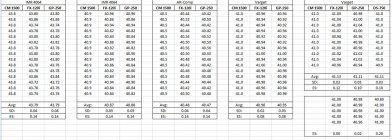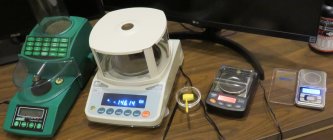After going thru several power outages in a evening, my FX-123i/Autotrickler might be fried. What is the next step-up in terms of accuracy, repeatability and speed?
Install the app
How to install the app on iOS
Follow along with the video below to see how to install our site as a web app on your home screen.
Note: This feature may not be available in some browsers.
You are using an out of date browser. It may not display this or other websites correctly.
You should upgrade or use an alternative browser.
You should upgrade or use an alternative browser.
Step Up from FX-120i/Autotrickler
- Thread starter FTRinTexas
- Start date
pikespeakgoat
Gold $$ Contributor
PatMiles
Silver $$ Contributor
I put a Tripp-Lite LS 606M upstream of my A&D.
The Prometheus is more than a step up as far as price goes. My question would be is it more accurate than ur FX-123i/ autotrickler? If u are weighing powder to a single kernel of powder now, all ur talking about is maybe a little decrease in dispensing time.
The old racing adage is “Speed costs money, how fast do u want to go”?
XTR
F-TR obssessed shooting junkie
The FX will weigh ( or at least Indicate) a single kernel of powder. In my 308 a load variation of 0.3 gr equals about 10 FPS give or take, so .03 ish variation from the scale would be in the range of 1 FPS or so. I can’t imagine how that is going to make a difference, at least to me.
as the above point out. Battery backup with power conditioning on the scale. Only way to go.
as the above point out. Battery backup with power conditioning on the scale. Only way to go.
The FX will weigh ( or at least Indicate) a single kernel of powder. In my 308 a load variation of 0.3 gr equals about 10 FPS give or take, so .03 ish variation from the scale would be in the range of 1 FPS or so. I can’t imagine how that is going to make a difference, at least to me.
as the above point out. Battery backup with power conditioning on the scale. Only way to go.
Hmmm??? Based on my "little" comparison (see pic below), and since ES is so important with only one poor measurement making a difference, the FX makes a substantial difference in terms of ES rather than an average FPS.

I've owned scales that read .002 grains and .01 and .02grains
Sartorious are great scales but going to .000 places its really sensitive and takes alot of care and patience. I still have mine and I also have the FX300i and in all honesty thats the way to go. it measures .02 grains and is perfect. the added benefit of this scale is it has a higher capacity over the 120i. This helps when you start adding heavier powder pans and then powder it seems to much more stable over the 120i in this factor.
Sartorious are great scales but going to .000 places its really sensitive and takes alot of care and patience. I still have mine and I also have the FX300i and in all honesty thats the way to go. it measures .02 grains and is perfect. the added benefit of this scale is it has a higher capacity over the 120i. This helps when you start adding heavier powder pans and then powder it seems to much more stable over the 120i in this factor.
I have the older Sartorious GD503 which weighs to .001gr. A single kernel of Varget "averages" .020 gr. So weighing to any level smaller than a single kernel of powder is useless. The issue becomes what powder variation vs case capacity makes a difference? How precise must the charge wt. be in say a 308 or 6.5x284 to have an effect on SD?I've owned scales that read .002 grains and .01 and .02grains
Sartorious are great scales but going to .000 places its really sensitive and takes alot of care and patience. I still have mine and I also have the FX300i and in all honesty thats the way to go. it measures .02 grains and is perfect. the added benefit of this scale is it has a higher capacity over the 120i. This helps when you start adding heavier powder pans and then powder it seems to much more stable over the 120i in this factor.
I don't know if the Prometheus is actually capable of weighing powder like Varget to exactly a .01gr charge weight everytime. The slight variations in the weight of a kernel of Varget comes into play and prevents that.
When I dispense powder with my measure and then trickle up into the Sartorious, I cannot always achieve .01gr charge weight consistency. Best is .01 to .02gr. range. The final charge is just a bit high or low of my target wt. Often I have to dump that charge back and start over again as the overall variation in the thrown charge by the measure is in a range that you cannot trickel (in one kernel increments) to a target charge wt.. It is sort of a stack up of the wt. of the individual powder kernels that the measure throws that puts the overall charge just under or over the charge wt. you are targeting. Reality is that some kernels of Varget are .015gr. and some are .025gr.
Example: I am looking at a final charge range (for a 308) of 46.01 to 46.02. In the process of trickling the charge up, the scale stops at 45.085 ,one kernel of Varget (.020) will put me at 46.005gr. Not enough. If when trickling up, the scale stops at 46.005, one kernel will put me at 46.025. Too much. You dump that charge back into the measure and start again.
So my contention is that given a light thrown charge of Varget, then trickling up in single kernel increments, the ability of that sort of system, is limited in the charge wt. range it can create. It doesn't matter what system you use, if the process begins with a powder charge thrown from a measure and then trickling up, .01 gr consistency is not really possible in each thrown/trickled charge. The range must be wider to accommodate the fidelity of the system and the wt. variations of a kernel of powder. Slower burning powders have a larger variation in kernel wt and make it more time consuming to weigh specific charge weights.
The only way to achieve consistent/specific charges (to .01gr.) is to use stick powders with very small kernels, or ball powders. It is the variations in the weight of a single kernel of powder that is the killer here.
I have the older Sartorious GD503 which weighs to .001gr. A single kernel of Varget "averages" .020 gr. So weighing to any level smaller than a single kernel of powder is useless. The issue becomes what powder variation vs case capacity makes a difference? How precise must the charge wt. be in say a 308 or 6.5x284 to have an effect on SD?
I don't know if the Prometheus is actually capable of weighing powder like Varget to exactly a .01gr charge weight everytime. The slight variations in the weight of a kernel of Varget comes into play and prevents that.
When I dispense powder with my measure and then trickle up into the Sartorious, I cannot always achieve .01gr charge weight consistency. Best is .01 to .02gr. range. The final charge is just a bit high or low of my target wt. Often I have to dump that charge back and start over again as the overall variation in the thrown charge by the measure is in a range that you cannot trickel (in one kernel increments) to a target charge wt.. It is sort of a stack up of the wt. of the individual powder kernels that the measure throws that puts the overall charge just under or over the charge wt. you are targeting. Reality is that some kernels of Varget are .015gr. and some are .025gr.
Example: I am looking at a final charge range (for a 308) of 46.01 to 46.02. In the process of trickling the charge up, the scale stops at 45.085 ,one kernel of Varget (.020) will put me at 46.005gr. Not enough. If when trickling up, the scale stops at 46.005, one kernel will put me at 46.025. Too much. You dump that charge back into the measure and start again.
So my contention is that given a light thrown charge of Varget, then trickling up in single kernel increments, the ability of that sort of system, is limited in the charge wt. range it can create. It doesn't matter what system you use, if the process begins with a powder charge thrown from a measure and then trickling up, .01 gr consistency is not really possible in each thrown/trickled charge. The range must be wider to accommodate the fidelity of the system and the wt. variations of a kernel of powder. Slower burning powders have a larger variation in kernel wt and make it more time consuming to weigh specific charge weights.
The only way to achieve consistent/specific charges (to .01gr.) is to use stick powders with very small kernels, or ball powders. It is the variations in the weight of a single kernel of powder that is the killer here.
Sometimes when I'm feeling obsessive over precise charge weights I'll have a little powder in the bottom a tiny glass bowl sitting on a piece of white paper so I can easily see the sizes of granules and select a shorter extruded granul, like with Varget or IMR-4064, when needed so that I can get the exact reading I'm looking for.
RICK SMITH
Silver $$ Contributor
The A&D HR100 is the scale I use. Super sensitive but worth it.
Does anyone else is use this? Do you need it to keep the measurements correct?I put a Tripp-Lite LS 606M upstream of my A&D.
On the chargemaster tests, did the chargemaster read at 40.9 for all of the charges?Hmmm??? Based on my "little" comparison (see pic below), and since ES is so important with only one poor measurement making a difference, the FX makes a substantial difference in terms of ES rather than an average FPS.
View attachment 1252321
For example, shot 1 was 40.78. Did the chargemaster still read at 40.9?
On the chargemaster tests, did the chargemaster read at 40.9 for all of the charges?
For example, shot 1 was 40.78. Did the chargemaster still read at 40.9?
Yes, that's right. I would trickle up until the Chargemaster read 40.9 then weigh the charge on the FX, which for shot 1 was 40.78.
I use the same method when I did my little comparison of the scales I had to get an idea as to what the different results might be. Maybe you already saw this on another thread?


I have been using a chargemaster for about 5 years now and just purchased the FX. Knowing now that Chargemaster can be off by .1 makes me hopeful I can get some better SDs with the FXYes, that's right. I would trickle up until the Chargemaster read 40.9 then weigh the charge on the FX, which for shot 1 was 40.78.
I use the same method when I did my little comparison of the scales I had to get an idea as to what the different results might be. Maybe you already saw this on another thread?
View attachment 1252859
View attachment 1252863
PatMiles
Silver $$ Contributor
I use the Tripp strictly as protection for my A&D, scale was always stable and correct before I added the Tripp.Does anyone else is use this? Do you need it to keep the measurements correct?
What exactly are you trying to achieve that the Fx120i/Autotrickler won’t do other than be destroyed by acts of God (lightening close by)?
You’re familiar with the term “diminishing returns”, correct?
If you’re current unit was smoked by lightening, just get another one. If it’s too slow for your liking, get two and install some. Line protection.
You’re familiar with the term “diminishing returns”, correct?
If you’re current unit was smoked by lightening, just get another one. If it’s too slow for your liking, get two and install some. Line protection.
Similar threads
- Replies
- 11
- Views
- 938
- Replies
- 14
- Views
- 1,509
Upgrades & Donations
This Forum's expenses are primarily paid by member contributions. You can upgrade your Forum membership in seconds. Gold and Silver members get unlimited FREE classifieds for one year. Gold members can upload custom avatars.

Click Upgrade Membership Button ABOVE to get Gold or Silver Status.
You can also donate any amount, large or small, with the button below. Include your Forum Name in the PayPal Notes field.
To DONATE by CHECK, or make a recurring donation, CLICK HERE to learn how.

Click Upgrade Membership Button ABOVE to get Gold or Silver Status.
You can also donate any amount, large or small, with the button below. Include your Forum Name in the PayPal Notes field.
To DONATE by CHECK, or make a recurring donation, CLICK HERE to learn how.









